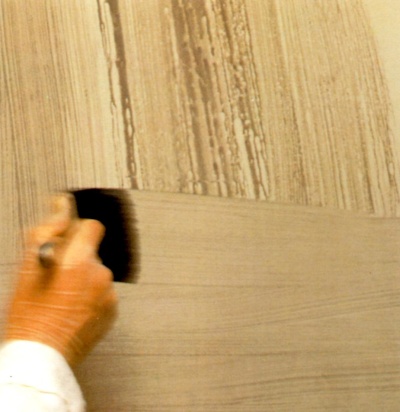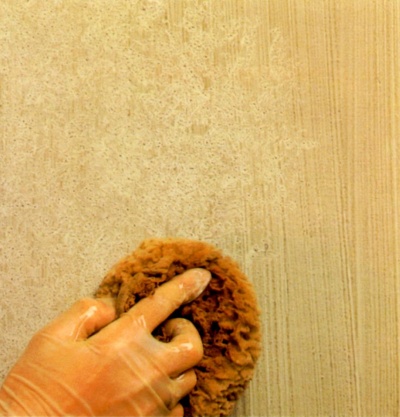Subtle Technique for Sponging Off Paint - Brush Application

Another way to sponge paint off
This negative sponging off method uses a paint brush for applying glaze, and produces a delicate, misty texture that is very pleasing.
The effect of this application technique resembles stippling - it creates a subtle, softly dappled finish which can add depth and visual interest to an otherwise boring, flat surface.
Just like with most other negative techniques, the process becomes faster and easier if one person brushes on the glaze, and another removes it with a sponge.
Timing is crucial - you don't want the painter to get too far ahead of the sponger, or the glaze will dry before the sponger reaches it.
But unlike the other subtractive methods, the multiple stroking required here levels out the glaze, and makes it possible for the glazer to begin removing it immediately, without having to wait for it to settle and gauge just the right time to remove it.
NOTE: because of all the brushing, the glaze tends to dry faster using this technique than when you apply it with a sponge or roll it on.
You don't get a lot of working time, so for this reason this method is recommended for smaller surfaces, especially if done in water-based mediums.
Preparation
Refer to the roller application tutorial for a list of tools and materials you'll need.Mix 1 part paint (in your desired color), 1 part clear glaze, and 2 parts solvent.
The glazing formula for this method should be thin enough to cover the surface easily, but not as thin that it won't adhere. Test a few samples on a practice board.
Pour a small amount of this glazing mixture into a paint tray. Put on the gloves and squeeze your sponge in the solvent.
TIP: Make sure you set aside the time to do an entire wall in one session, so that the leading edge will be wet when you paint the adjacent section.
In the following example, a tan oil-based glaze is worked over a base coat of warm white latex paint. The paint was allowed to dry thoroughly before the glaze was applied with a brush.
Instructions
1) Using a fully loaded brush, apply a thin coat of the glaze with 3 sets of criss-cross strokes.First, make vertical strokes from top to bottom. Second, run the brush horizontally, side to side. And third, move in vertical strokes, top to bottom again.
This covers the surface evenly and sets up the glaze for sponging off.

Reload the brush as needed. Apply the glaze in 1-foot wide strips at a time, so that it remains wet and workable.
2) Pounce the damp, clean sponge lightly and evenly on the wet glaze, to remove some of it.
Work over the 1-foot area, repeatedly patting it with the sponge. Turn the sponge slightly in the air by making a twisting motion with your hand - to avoid creating an identifiable pattern.
This will soften and blend the strokes. Each stroke should just touch the previous one, so that about half of the glaze is lifted off.

Clean and wring the sponge often during the process to prevent glaze buildup.
TIP: it's better to remove too much glaze than too little. You can always go over the surface with more glaze, if necessary.
3) As you get to a corner, scrunch up the sponge (or tear off a small piece) so you can dab it into the tight space to remove the glaze.
When a 1-foot area is completed, the surface should be dry enough to hold its pattern. But if the glaze is still runny or saggy, go over the surface quickly with a fresh damp sponge.
Note, however, that this will lighten the finish.
4) Repeat Steps 1-3 to complete the wall. Make sure the edges of new 1-foot strips meet, but don't overlap - otherwise the joints will form dark demarcation lines.
5) The final finish should look like a soft, painterly, velvet-like texture.

As with all subtractive techniques, the more glaze you remove, the lighter and subtler the finish you create (provided you used a darker glaze over a lighter base coat).
Return to Sponging Off Paint Techniques.








